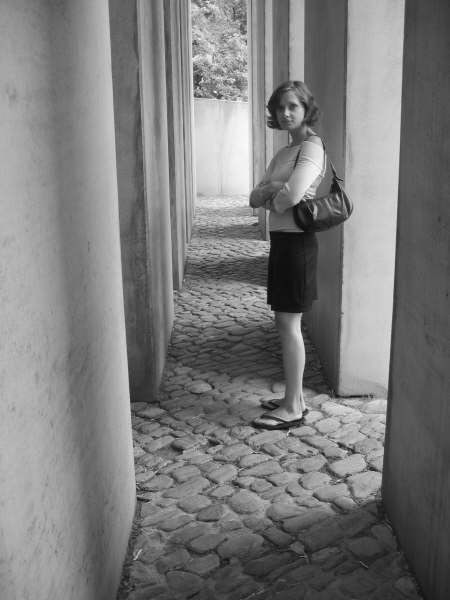I have a knot of thoughts clogging up my brain right now. In my mind's eye, the knot resembles that representation of a protein interaction network that I included in
my post about visualizing complex networks. The difference between that complex network and my thoughts, however, is that my thoughts are all very simple. They've just managed to get all tangled, like that big ball of outdoor Christmas lights that has sat in the corner of the garage since last January.
I think the knot is both a result of my long silence on this blog, as well as a reason for the continuation of that silence. Over the past few weeks I've been scribbling wee notes to myself full of future blog ideas. These crumpled pieces of paper have been collecting in a pile on my desk. They're intimidating - much, much more so than a small stack of personal notes should be. Of course, they're now of no use to anyone (least of all to me) . I've realized that the moment is clearly not going to come when I'll craft the disparate thoughts into an eloquent essay. So, for the preservation of my sanity, I'll spill them out here. Perhaps I can revisit this mess later and make something more of them. Hopefully, that "something" can be more than just the sum of all of its parts. That would be very satisfying, as the broad subject of my thinking has been networks.
The topic of
mashups, and the ecological metaphors some have used to describe them, helped me think about networks in new ways. I published my
post on that topic this morning, and then walked down to do some reading at the Red Roaster Cafe in the
London Public Library. When there, a friendly guy, apparently interested in the remarkably uninteresting "Europe in the Sixteenth Century" textbook I was reading, struck up a conversation. We didn't even talk for ten minutes, but in that time I learned that he had studied visual art at Concordia, and most likely was in the same courses as one of my close friends.
We often exclaim, "what a small world!" We (as in our world's population) have relationships that comprise a very complicated network. Again, our messy-looking friend, the protein interaction network, could represent those relations. Wouldn't it be neat if everyone could just stand still for a couple of months, and an artistic/research team could run around tying strings between people to represent their relationships. We would all end up the ultimate Christmas light-esque knot.
It all has the makings of a weird Douglas Coupland installation project.
See, for example, Coupland's "Super City" piece at the CCA. Indeed, it's likely that many artists have produced work on this theme, and I'd love to learn more about their work. In fact, I would love to take up a project on the theme. Inspired by
Visual Complexity's statement "the whole (of a network) is always more than the sum of its parts", I would learn how to make an appealing and intriguing-looking visualization network to represent, and teach about our relationships. I would encourage other interested researchers to use my aggregated data for their own applications. (Really,
all of this reading about some of the fabulous components of Web 2.0, such as collaboration, social bookmarking, open-access and open-source applications, peer-to-peer sharing, APIs and recombinance is turning me into a socialist). Inspired by the mashup
outside.in, I would seek to map out, locate, and represent the invisible relationships we share. It would be my goal for the virtual community to enhance the actual community.
The first community I would target for this kind of application would be one I'll call the Depot Harbour diaspora. DH is now a ghost town, and is located near Parry Sound. My partner is currently doing a fascinating oral history research project on the place. He has taken on this project because his grandfather used to live and work in the once-thriving community. Mark recently interviewed a number of relatives on their experience with the town, and their memories since they have left. His goal is to bring the people back into historical interpretations of the space - to repopulate the creepy (in a bad way)-looking photos we have now of empty lots where community churches once stood.
After sharing a litre of wine and a lengthy, exciting conversation about his project, Mark got me to thinking that some kind of visual map of the relationships between former DH residents, and of their current locations, would be a really neat thing to have. All of the people moved somewhere, and they took great stories with them. What if we could collect those stories, map them out, and indicate contextual/topical relationships that their stories reveal? Our interview subjects could continually add to this network. (For a visualization of these connections, I'm thinking of using something similar to the "strings" that connect subjects in the
McCord's concept network interface).
In the end, isn't it among the historian's goals to repopulate the dusty, dead and now-empty places of the past? I'm looking forward to thinking about ideas of place and community identity-building in our
500 class on 15 November. I think that Chris Lorenz's [1] writing on space, time, and place-in-time opens up neat areas for discussion about the ways communities make identies, and the ways we can learn about the meaning they give to those identities.
Of all of my recent disconnected thoughts, the one most relevant to the current work of our own little community of UWO Public History MA students is that about repopulating past communities of Londoners by using the artifacts at our disposal. Just as a mashup contains innumerable clues about its parent community, so does an apple corer - though, as
Kelly has written, that corer could maybe do with being a little sexier. If
our exhibit can teach our visitors about the meaning an apple corer, a bovie, a gestetner or a slide projector had in a London community - or, rather, how such inventions affected/were used by the community - I think we'll have done a good job.
-------------------------------------------------------------------------------
[1] Chris Lorenz, "Toward a Theoretical Framework for Comparing Historiographies: Some Preliminary Considerations,"
Theorizing Historical Consciousness, ed. Peter Seixas (Toronto: University of Toronto Press, 2004), pp.25-48.


